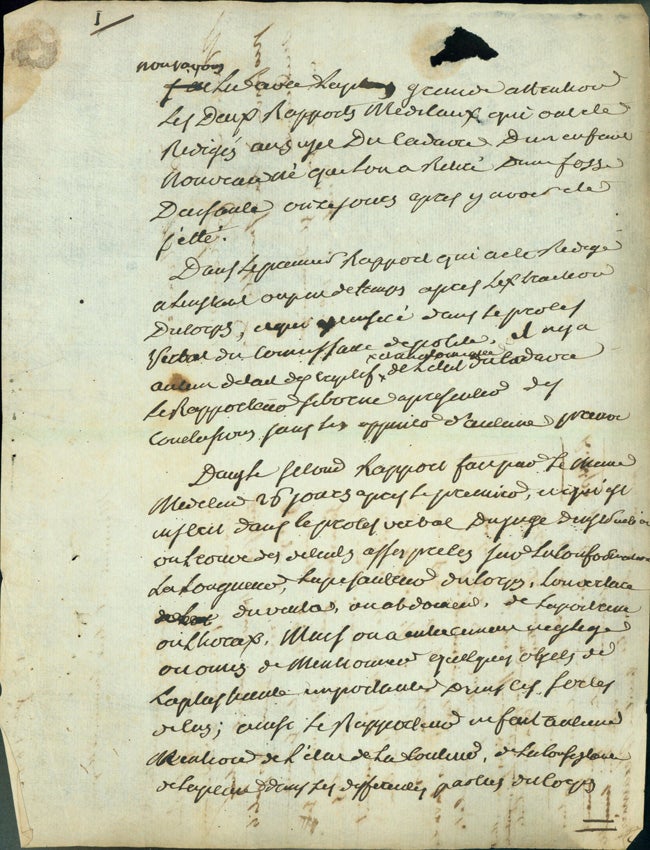
Autograph manuscript signed. 10pp., with Recamier Autograph letter signed.
Publisher Information: Paris: 1822.
Chaussier, François (1746-1828). Autograph manuscript draft. 10pp. on 10 numbered leaves. [Paris:] 3 February 1822. Written on the backs of several printed and manuscript documents, including the following: Recamier, Joseph (1774-1852). Autograph letter signed to Chaussier. 1 page plus integral address leaf. [Paris:] 17 January 1822. Together two items. 254 x 201 mm. A few lacunae where seals were broken, a few pin-holes, minor marginal fraying, but very good.
Chaussier, a pioneer in forensic medicine, introduced the teaching of legal medicine in France in 1790. He began his medical career in Dijon, where he taught anatomy, chemistry and material medica at the Dijon Academy. In 1794, at the request of the French government, Chaussier went to Paris to help reorganize the country's system of medical education through the creation of the Écoles de Santé. He afterwards served as professor of anatomy in the new school, taught the course of chemistry and medicine at the École Polytechnique, and worked as a physician at the Hospice de la Maternité, where he conducted research on teratology and forensic medicine. During his long and distinguished medical career Chaussier earned a reputation as an expert in legal medicine, giving consultations, writing forensic reports, and publishing several works on the subject, including Manuel médico-légal des poisons (1824), Recueil de mémoires, consultations, et rapports sur divers objets de médecine légale (1824) and Mémoire médico-légal sur la viabilité de l'enfant naissant (1826).
Chaussier's manuscript draft is a review of two earlier medical reports concerning the case of a newborn infant found dead in a cesspool. Chaussier's handwriting is difficult to read, and we have not been able to decipher all of the draft; however, we have been able to determine that much of the draft is devoted to discussing the state of the dead infant's lungs, attempting to determine whether the infant had begun to breathe before its demise. Chaussier describes the appearance of the lungs of dead infants in similar cases:
Un enfant naissant meurt quelques minutes après avoir respire et dans ces cas, dont nous avons souvent des exemples a l'hospice de la maternité, les poumons sont toujours développés, rosés, crépitants, leur poids […] et lors qu'on les met dans l'eau ils submergent complètement.
[A newborn infant dies several minutes after having breathed and in these cases, of which we often have examples at the Hospice de la Maternité, the lungs are always developed, pink, crepitant, their weight […], and when one puts them in water they always sink completely.]
And elsewhere:
Mais remarquons . . . selon qu'un enfant est mort après avoir respiré, faut-il donc en conclure ainsi qu'on le fait trop souvent que cet enfant a été tué.
[But note. . . if a child died after breathing, it should be concluded as one does too often that this child was killed.]
He also notes that the infant's umbilical cord was not present, and mentions the possibility that gas present in the infant cadaver's lungs might be the result of putrefaction, given the fact that the body had been in the cesspool eleven days before its discovery.
Chaussier wrote this draft of his report on the backs of several printed or manuscript documents, including a letter sent to him a few weeks earlier by Joseph Recamier, chief physician at the Hôtel-Dieu, a pioneer in gynecological surgery (see Garrison-Morton 6033), and a cancer specialist who came up with the modern definition of metastasis. The letter reads as follows:
Monsieur et très honoré collègue,
On doit traiter une question de médecine légale au sujet d'un chevreuil et d'une dindonneau truffée trouvés morts chez Gri[…] rue neuve des petits champs no. 4. La séance s'ouvrira par une discussion sur les empoisonnements par les huitres le 24 jvr. courant à 3h et . On écoutera avec soin la question des champignons malgré les favorites […] du docteur [ ?poulet].
Voyez, si vos affaires vous permettent d'être du […] dans des questions aussi importantes. Ce sera pourtant la […] et pour moi en particulier un plaisir de plus. J'ai l'honneur d'être parfaitement Monsieur et cher maitre votre très humble serviteur Recamier.
[We must deal with a question of forensic medicine in the matter of a deer and of a young truffle-stuffed turkey found dead at Gri[…]'s, rue neuve des Petits Champs no. 4. The session will begin with a discussion on oyster poisoning on the 24th of this January at 3:30. We will consider carefully the question of mushrooms despite the favorite […] of doctor [?chicken].
See if your affairs will allow you to be […] on such important questions. This will yet be […] and for me in particular an additional pleasure. I have the honor to be, Monsieur and dear master, your very humble servant, Recamier.]
Recamier's letter is most likely a jocular invitation to dinner, referring humorously to a proposed forensic investigation into the deaths of a deer and a truffle-stuffed turkey, a discussion of poisoning by oysters, and "the question of mushrooms." Burton, Napoleon and the Woman Question (2007), pp. 97-98.
This is the only autograph manuscript by Chaussier we have handled in more than forty years of trading. It is also the only manuscript we have ever handled in which the author wrote his draft on the back of other documents.
Book Id: 40393Price: $3,500.00
